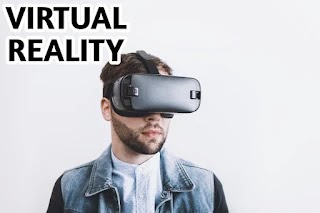Virtual reality encompasses the creation of artificial three-dimensional (3-D) environments through computer modeling and simulation, offering an immersive experience facilitated by interactive devices like goggles, headsets, gloves, or body suits. This technology, popularized in the 1980s, transports users into computer-generated environments, providing a sense of "being there" known as telepresence. Motion sensors track user movements in real time, adjusting the view on the screen accordingly, while data gloves equipped with force-feedback devices allow users to interact with and manipulate objects within the virtual environment.
Virtual reality definition:
Virtual reality (VR) is a technology that has transformed the way we interact with digital environments, offering immersive experiences that blur the lines between the real and virtual worlds. This article explores the evolution of VR, its various applications across different industries, and the challenges and potential risks associated with its use.
The Evolving Landscape of Immersive Technology
• The term "virtual reality" was coined by Jaron Lanier in 1987, highlighting its roots in various fields, including computer graphics, simulation, and networked environments. Government agencies such as the Department of Defense, the National Science Foundation, and NASA played a significant role in funding projects at university-based research laboratories, fostering talent and establishing links between academic, military, and commercial sectors.
• Before computers, attempts to create immersive experiences involved techniques like panoramic paintings and theatrical designs aimed at blurring the boundaries between 2-D images and 3-D spaces. Innovations such as the Cinerama widescreen film format and Morton Heilig's Sensorama Simulator laid the groundwork for modern VR by incorporating sensory stimulation to simulate realistic experiences.
• In the 1950s and 1960s, projects in 3-D interactive computer graphics and vehicle/flight simulation, like Project Whirlwind and SAGE, pioneered the use of cathode-ray tube (CRT) displays and input devices. Joseph Licklider's concept of "man-computer symbiosis" and Ivan Sutherland's work on computer graphics further advanced the idea of immersive virtual environments. Sutherland's Sketchpad in 1963 and his head-mounted display (HMD) in 1967 marked significant milestones in interactive computer graphics, enabling users to draw on a CRT display and view computer-generated graphical output in stereo 3-D.
• VR found early applications in education and training, particularly in military simulations and pilot training, providing cost-effective and safe alternatives to real-life scenarios. Edwin Link's Link Trainer, developed in the late 1920s, was among the first simulators used for pilot training, utilizing motion feedback to simulate flight controls.
• Overall, virtual reality represents a fusion of technology, creativity, and human-computer interaction, with applications across education, entertainment, and beyond, poised to redefine human experiences in increasingly immersive ways.
Virtual reality applications
Despite these challenges, VR holds immense promise for the future of work and collaboration. As technology progresses, VR headsets may rival traditional monitors in display quality, paving the way for widespread adoption in various industries.
• Humanoid robots :
In parallel, humanoid robots like Nadine, Geminoid DK, Junco Chihira, Jia Jia, and Sophia showcase the progress in replicating human-like interactions. These robots, equipped with personality, mood, and emotions, blur the line between human and machine, opening new frontiers in customer service, inspection, and maintenance.
• The Convergence of VR and Humanoid Robotics: The convergence of VR and humanoid robotics paints a compelling vision of a future where humans interact seamlessly with virtual environments and lifelike robots. While challenges persist, the relentless pursuit of realism and immersion propels technology towards a future where the boundaries between reality and simulation blur indefinitely.
• Society: Virtual Reality (VR) and Augmented Reality (AR) are rapidly evolving technologies that are becoming integral parts of our society, influencing various aspects of our lives from entertainment to education and training. VR immerses users in simulated environments designed to mimic the real world, while AR overlays digital content onto the physical world. These technologies have already made significant impacts on society and are poised to play even larger roles in the future.
• Entertainment: In the realm of entertainment, VR is revolutionizing how we experience games, movies, and TV shows. VR headsets provide users with immersive gaming experiences, transporting them into virtual worlds where they can interact with characters and environments in ways never before possible. Similarly, VR is enhancing the viewing experience of movies and TV shows by offering viewers a heightened sense of presence and engagement. This technology has the potential to create interactive amusement park rides and virtual theme parks, further blurring the lines between reality and fiction in entertainment.
• Virtual reality in education: Education and training are also benefiting from the advancements in VR and AR technology. Virtual reality simulations are providing students with immersive learning experiences, allowing them to explore subjects like never before. For example, medical students can practice surgical procedures in virtual environments, providing a safe and realistic training environment. AR is being used to enhance traditional learning materials by overlaying digital content onto textbooks and worksheets, making learning more interactive and engaging.
• Industries: In addition to education, VR and AR are transforming the way we train employees in various industries. From healthcare to manufacturing, virtual reality simulations are being used to train workers in complex tasks and procedures. For instance, factory workers can practice operating machinery in virtual environments, reducing the risk of accidents and injuries in the workplace. AR is also being used to provide real-time guidance and information to workers, improving efficiency and productivity.
• Other fields: Beyond entertainment and education, VR and AR have diverse applications in fields such as healthcare, architecture, engineering, and marketing. In healthcare, VR is being used for medical training simulations and therapeutic interventions, while AR is being used for surgical navigation and patient education. Architects and engineers are using VR to create immersive virtual models of buildings and infrastructure projects, allowing them to visualize designs and identify potential issues before construction begins. Marketers are using AR to create interactive advertising campaigns that engage consumers in unique and memorable ways.
Overall, augmented reality and virtual reality are revolutionizing the way we interact with the world around us. These technologies have already had a significant impact on society, and their influence is only set to grow as they continue to evolve and become more accessible. From entertainment to education and beyond, VR and AR are shaping the future of how we experience and interact with the world.
Challenges and Future Outlook
In recent years, Virtual Reality (VR) and Augmented Reality (AR) have emerged as powerful tools with diverse applications across various sectors. These technologies simulate real-world scenarios, offering users immersive experiences that range from educational simulations to interactive gaming and virtual meetings.
• Customer engagement : The adoption of VR and AR has seen significant growth, particularly in training and education. Medical students, for instance, can now practice surgical procedures in a safe and controlled virtual environment, while engineers utilize AR to visualize and manipulate complex machinery. In the business realm, companies are leveraging VR to showcase products and services, enhancing customer engagement and providing more immersive shopping experiences.
• Healthcare: In particular, has witnessed transformative applications of VR and AR. These technologies are used to manage chronic pain, anxiety, and depression by providing patients with immersive environments for therapeutic purposes. Additionally, VR is enhancing medical training and improving the overall patient experience during hospital stays and medical procedures.
Risks in Virtual Reality
Despite the myriad benefits, VR and AR also pose challenges and potential risks. The immersive nature of these experiences can lead to addiction and isolation, while prolonged exposure may impact eyesight and mental health. It's essential to carefully consider and manage these risks as these technologies continue to evolve and integrate into daily life.
Conclusion:
virtual reality (VR) and augmented reality (AR) technologies have undergone significant evolution and have become integral parts of various industries, including entertainment, education, healthcare, and beyond. These immersive technologies offer unprecedented experiences, from interactive gaming to realistic medical simulations, revolutionizing the way we interact with digital environments. However, along with their myriad benefits, VR and AR also bring challenges and potential risks such as addiction, isolation, and health impacts. As these technologies continue to evolve, it's crucial to carefully manage these risks while harnessing their transformative potential to shape the future of human experiences and interactions.



.jpg)





